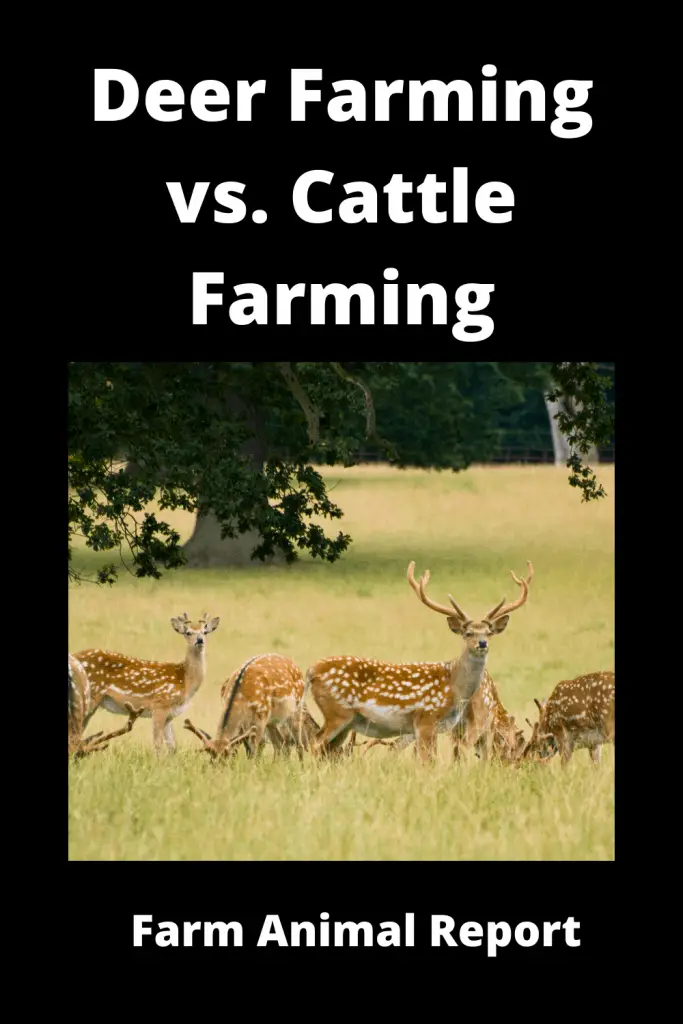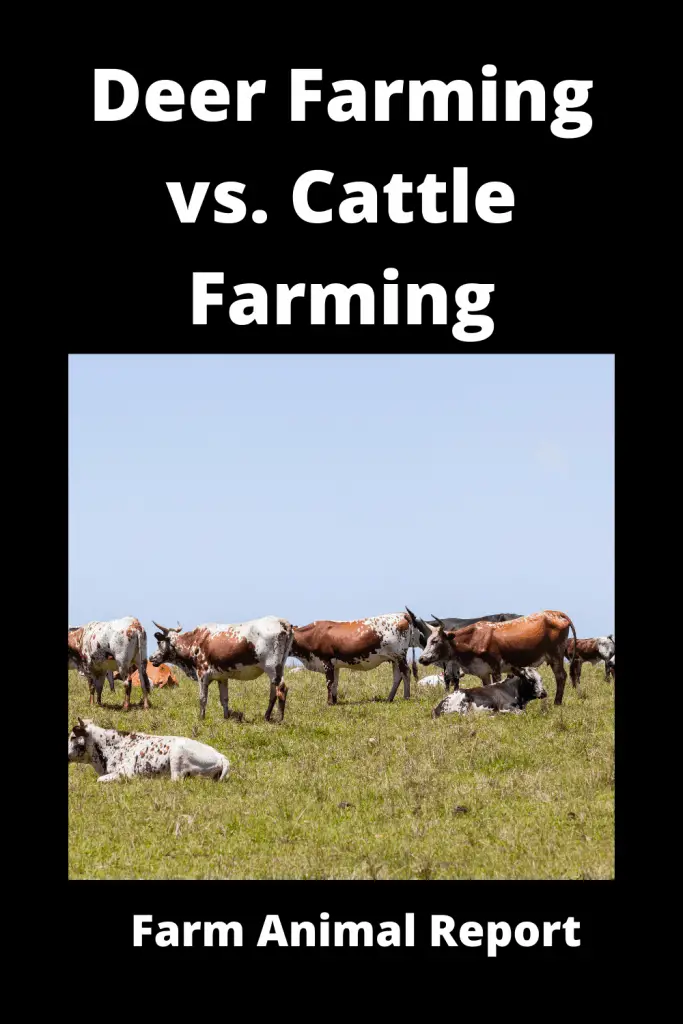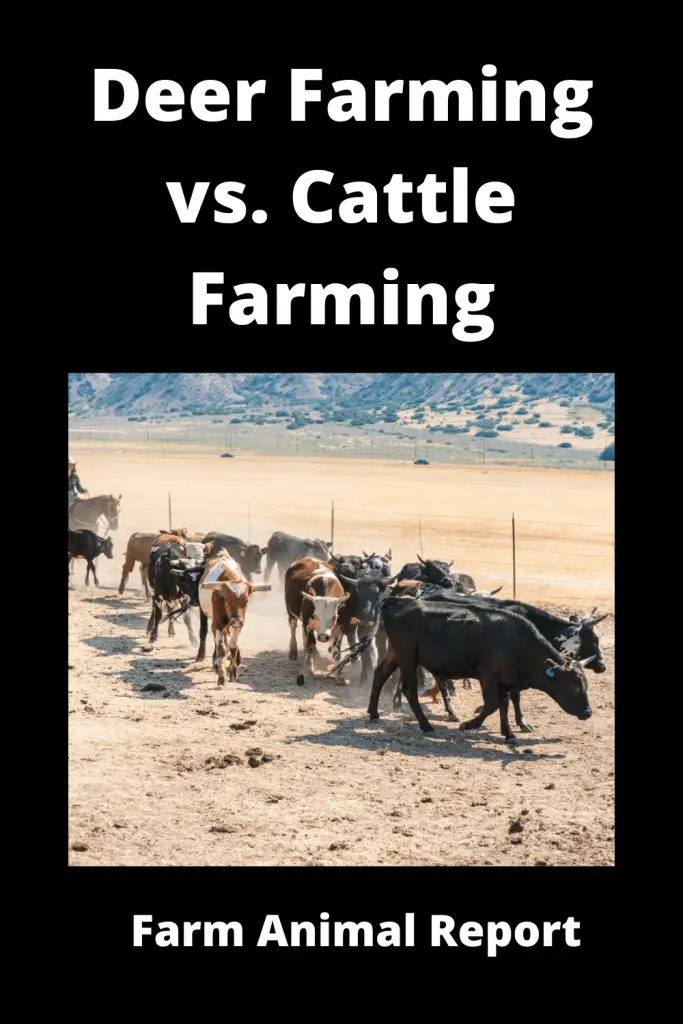Deer vs Cow Farming
The main difference between Deer vs Cow Farming – Deer Farming has exploded in the last 10 years, as the Demand for Lean, Low-fat Meat has increased in the World Wide Market. Deer are able to forage in Minimal Pasture settings. They Require Unique handling Methods in their Domestication
To learn more about Raising Cattle Check out Amazons Resources
- Deer Mature Quickly
- Deer Often have two Fawns per Year
- Birth fawns easily – Fewer complications
- They can easily live on minimal pastures
- Lean Meat Produced
- Trophy Deer Market
- Antler Harvesting market
- Deer Hide Market
- Selling Sperm Market
- Breeds Lineage market – Featuring Large Racks
- Very Long Fawn Birthing Years
- Tolerate Hot and Cold Temperatures Heartily
- Currently, US only produces 20% of Consumption – Rest is Imported Mostly from New Zealand and Australia
- Stocking Hunting Reserves
We will explore many of the Pro’s and Con,s in comparing them to Raising Cattle for Meat Production. Deer vs Cow Farming They Have Unique processes that need to be taken into consideration for the aspiring Deer farmer.
Check Out Amazons Educational Books on Whitetail Deer

We put together a complete Guide to Commercial Deer Farming you can view it here. It goes into a lot more of the details you will need to consider.
Deer Farming as Compared to Cattle Farming
Deer farming
One of the major differences in the Height of fencing needed to contain the deer. Deer can jump 8′ in height. If you used slanted fencing the height can be lower. The fencing of deer in a piece of land that is adaptable to grazing and is highly populated with species of deer commonly with elk, moose, reindeer, and especially white-tailed deer.
See Our Extensive Article – 7 Ways Deer Farmers Make Money
When They are raised as livestock. This article from the University of Vermont, Dr. Leonard Perry – Horticulture Professor – Details Fencing Required for Deer Farming.
See Our Guide – Ways to Make Money Cattle Farming
Deer Breeds
Types of Deer for Deer Farming
| Breed of Deer | Weight | Price of Venison | ||
|---|---|---|---|---|
| Whitetail | Buck - 150 lb Doe - 100 lbs | $ 29.50 | ||
| Mule | Buck - 150 - 300 lbs Does - 95 - 200 lbs | $ 44.95 | ||
| Red | Buck 350 - 530 lbs Doe 260 - 370 lbs | $ 21.95 | ||
| Fallow | Buck - 130 - 200 lbs Does - 60 - 90lbs | $ 39.95 | ||
| Axis | Bucks 150 - 250 lbs Does 90 - 150 lbs | $ 43.95 | ||
| Reindeer | Buck 350 - 400 lbs Does - 180 - 260 lbs | $ 74.95 |
Is Deer Farming Profitable
Deer / Cervid Farming / Profitability Table
| Deer Type | Ave Weight | Average Calves/Yr | Gestation | Meat Retail Price/lb |
|---|---|---|---|---|
| White Tailed | 150 | 2 | 201 | $ 38.95 |
| Mule | 120 - 320 | 2 | 203 | $ 7 - 9.50 |
| Elk | 71- - 730 | 1 | 240 - 262 | $ 44.95 |
| Reindeer | 350 - 400 | 1 | 222 | $ 74.95 |
| Moose | 840 - 1500 | 1 | 243 | $ 7.50 |
| Sika | 93 | 1 | 224 | 34.95 |
| Red | 440 | 1 | 236 | $ 35.95 |
| Pere David's | 370 | 1 | 286 | |
| Axis | 79 | 2 | 227 | $ 29.99 |
| Mutjah | 30 | 1 | 214 | $ 39.95 |
Deer Farming Start-Ups can be Small
- 10 Acres for Start-up
- Approx 400 hours of labor time
- $ 100,000 initial Investments
- Barn Shelters optional
- Penn State University – Deer Farming Start-Up Guidance

3 Major Points
- But Your Stock from a Reputable Breeder
- Find a Veterinarian – Experienced wit Deer – Exotic Hoof Stock
- Find a mentor – many times the Breeder that sells you stock – will share a wealth of information with you
Cattle Farming
Cattle farming may be called the process of raising the calves to an age that it becomes the source of milk or food and can be consumed by human beings.
Beef cattle raisers raise the male calf to appoint that it becomes large enough to provide a good or fair quantity of meat at slaughter.
Comparison of Deer and Cattle Farming
Deer farming is considered more profitable as compared to cattle farming due to the following reasons
- Deer mature quickly
- They can reproduce up to 20 years of age if kept in captivity
- They require less fodder
- They are less damaging to pasture
- They require less space
Similarities Between Deer and Cattle Farming ‘
Deer Farming | Cattle Farming |
| Various environmental conditions favor deer farming. | The environment required for cattle farming is the same as is required for deer farming. |
| Deer farming can be beneficial in meeting the increasing demand for meat. The meat of deer is liked mostly by the economical class of people as it is a costly and rich source of proteins. | Cattle farming is providing milk and draught services as well as a major contributor as a source of protein i.e meat. It is most common in middle-class people and mostly liked by them. |
| Deer farming is a source of livelihood for many people and provides a good source of employment. | Cattle farming is considered the sole source of earning and in many developing countries about thirty percent of the families are associated with this source of earning. |
| Deer are ruminants and have a compound stomach having four compartments comprising rumen, reticulum, omasum, and abomasum. It surely means that both are dependent on the same type of feed.
| Cattle just like deer are also ruminants and have the compound stomach.
They eat a wide range of fodders and do have the process of regurgitation. |
| They are adaptable to various environmental conditions | They are also adaptable to various environmental conditions. |
| They are easy to manage. | They are easily manageable and can be kept in a wide range of areas. |
| With minimum output, larger profits can be obtained. | With minimum input, a large amount of profit can be obtained as the cattle farming can be started with one or two female animals and may result in a greater herd. |
Deer farming is profitable as it requires less space than the cattle and is easily confined in any place.
Differences Between Deer and Cattle Farming
DeerFarming Cattle Farming
| Age at puberty
They attain puberty at an early stage of age ranging between sixteen to eighteen months. They are likely to conceive their first pregnancy at the age of twenty -four months. The puberty age depends upon the nutrition breed and environmental conditions. Early age at puberty means it is better for the source of earning earlier. | Age at puberty
They usually attain puberty at the age of thirteen to fourteen months of age. They usually conceive at fifteen months of age. Age at puberty does vary with breed, weight and, nutrition. |
| The life span for breeding
Deer live fifteen to twenty-five years of age on the average. They get pregnant eight to ten times in their lifetime. They usually have two to three babies at each parturition and mostly have two babies at each parturition. So the number of fawns received by a female deer is almost double as compared to cattle. So it is more profitable. | The life span for breeding
Cattle on the average can breed up to eight to ten times. cattle can have eight to ten parturition in its lifetime. But this does depend upon the nutrition and management conditions in which they are raised. The average life span of cattle is usually eighteen to twenty years. They usually have one baby at each parturition and occasionally may have two. |
| Gestation period
The gestation period in deer differs in different breeds of deer as it is 290 days in Roe deer and it is 210 days in Indian muntjac. So the average gestation period in deer is considered seven and a half months. They have the breeding season in months or September October and November. They usually mate in the month of October and give birth to babies in the month of late May and up to the month of June. As deer have shorter gestation period than that of cattle so they are easy to manage and it is more profitable and it requires less time to give birth to the baby so it decreases the per capita cost on feeding and nutrition so it is more profitable. | Gestation period
The gestation period in cows also does vary but in a smaller range. Its variation mainly depends upon the breed and sex of calf. It ranges between 279 days to 287 days. Cows at an older age tend to have more gestation period. They usually breed in the months of June July so they will have calves being born in the months of March and April. Cattle have a longer gestation period so per capita cost is increased. As of increased pregnancy days, cattle farming is considered less profitable as compared to deer farming.
|
| Number of Fawns
The number of parturition in the lifetime of deer is approximately the same as that of cattle but the number of babies in parturition is mostly two in number and maybe three. So in the same period of time, the number of deer is almost double to that of cattle so deer farming is more profitable. | Number of Calves
The cattle in its lifetime particulates almost eight to ten times and has one baby on average or may have two calves. So a number of calves at the same time as compared to the deer is almost half. So cattle farming is considered less profitable as its production capacity is half as compared to deer. |
| Damaging to pasture
Deer are considered less damaging to pastures as they are intermediate feeder between grazer and browser and are adapted to grazing grasses, forbs, and woody plants. They can also take feed intended for cattle. As deer are less damaging so can be allowed to graze in wet fields and considered more profitable. | Damaging to pasture
Cows like to graze on rolling lands although they can graze anywhere as a heavier animal, they can cause more damage to pasture as compared to lighter animals like sheep, goat, and deer. Wet pasture is more vulnerable to damage so wet fields are more damaged than that of dry fields. As they are damaging to pastures so the cost of feed is increased so it is less profitable as compared to deer farming
|
| Daily feed intake of deer
Daily feed intake in deer is much less as compared to smaller bodies. If the live body weight of deer is a hundred kilogram then daily energy requirement is thirty-six and daily dry matter intake is three-pointnine. It is almost six to eight kg per deer per day. The cost of feed intake in deer is much less as compared to cattle so it is considered more profitable than that of cattle. Less cost on feed means less investment as it is single purpose farming clearly meaning to say it is done for meat purposes. It is liked by the upper economic class. It is affordable by the upper economic class too. | Daily feed intake of cows
Cows consume dry matter intake almost two percent of their body weight. If a mature cow is 400 kg then 2 percent of its body weight will be eight-kilo grams of dry matter. If the moisture content included in this feed intake it is almost thirty to forty kg in each cow. As daily feed intake cost is high in cattle because daily feed intake is almost three times the deer so it is less economical. But in cattle, there is the advantage of milk production so the cost on feed can be ignored as it is doing good along with high expense. Cattle farming has a plus point of milk production over deer farming but this enhances the problems in management as it becomes difficult to milk the cows two or three times a day and labor cost is increased. Any how management is difficult but is profitable. |
| Purpose of farming
Deer farming is considered a single purpose as it is done to meet the increasing demand for meat. It provides high- quality meat with a high level of proteins and other essential nutrients. It is a highly economical business as deer meat is only affordable by the upper economy class so it is highly affordable. | Purpose of farming
Cattle farming is considered multidimensional as it can be done for the purpose of many profitable sources of earning. It can be done to meet the growing demand for meat and can also be done to increase milk production and can be reared to enhance the generation streak of valuable animals generation after generation by preserving their sperm and to fertilize with thousands of female cows. It can also be done to produce healthy animals that can be employed for the purpose of draught. In this aspect, cattle farming is more vast and profitable as compared to deer farming. The livelihood of many people can be related to this type of farming. |
| Space requirement for deer
Apparently space required by deer is much less as compared to cattle as the body size is much smaller as compared to cattle so a larger number of deer can be raised in the same area. Its body size is almost half as compared to cattle. For deer to move freely and live without stress it requires 15,000 square feet and with each deer added the space required increases by 3000 square feet up to the addition of total number four. For more than four then an additional 20,000 square feet is required by each deer. | Space requirement for cattle
Space required by a cow on the ground surface is 3.5 square meters per cow and the height required is almost six feet. It is much greater than that of deer but much more land is reserved is for cattle to meet its feed requirements. It is generally considered a thumb rule that approximately 1.5 to 2 acres of land must be reserved for a cow pair calf to feed for the time of 12 months. If it is considered on mature cow this land is 1.8 acres per cow. It is still less than that of deer and is considered a plus point in cattle farming. |
Conclusions
As described above there are similarities and differences in deer and cattle farming. Both types of farming are profitable if compared economically then the profit margin in both cases is comparable.
Deer farming is considered business class i.e farming at a higher level because higher a level of space requirement is there. To maintain the good health of the farm hygienic conditions maintained and to meet daily body requirements energy-rich diet needs to be provided.

The incidence of disease in deer is considered less as compared to that of cattle because they are more resistant and have fewer reproductive problems. In terms of profit it highly profitable as increased sugar increases the sweetness. It is considered some sort of sober business.
While as compared to deer, cattle farming is considered lower class business as it requires lesser investment and can be started with one or two cows. Most of the cattle under rearing are to the farmers that take it as a side business. And get their daily requirements of milk get completed. However, they may acquire earning by selling surplus milk. And the calves they get at each parturition are also sold either for meat or for some other purpose.
However farming at an upper level requires greater attention, greater managemental facilities, greater veterinary assistance, and greater land for fodder. In short, both the farming are profitable if accomplished through zeal and dedication
Deer Farming Resources
- North American Deer Farming Association
- Deer Farm Directory
- Pennsylvania Deer Farmers Association
- New Zealand Deer Farmers Association
- Deer Farming Association of Australia
Thank you!


